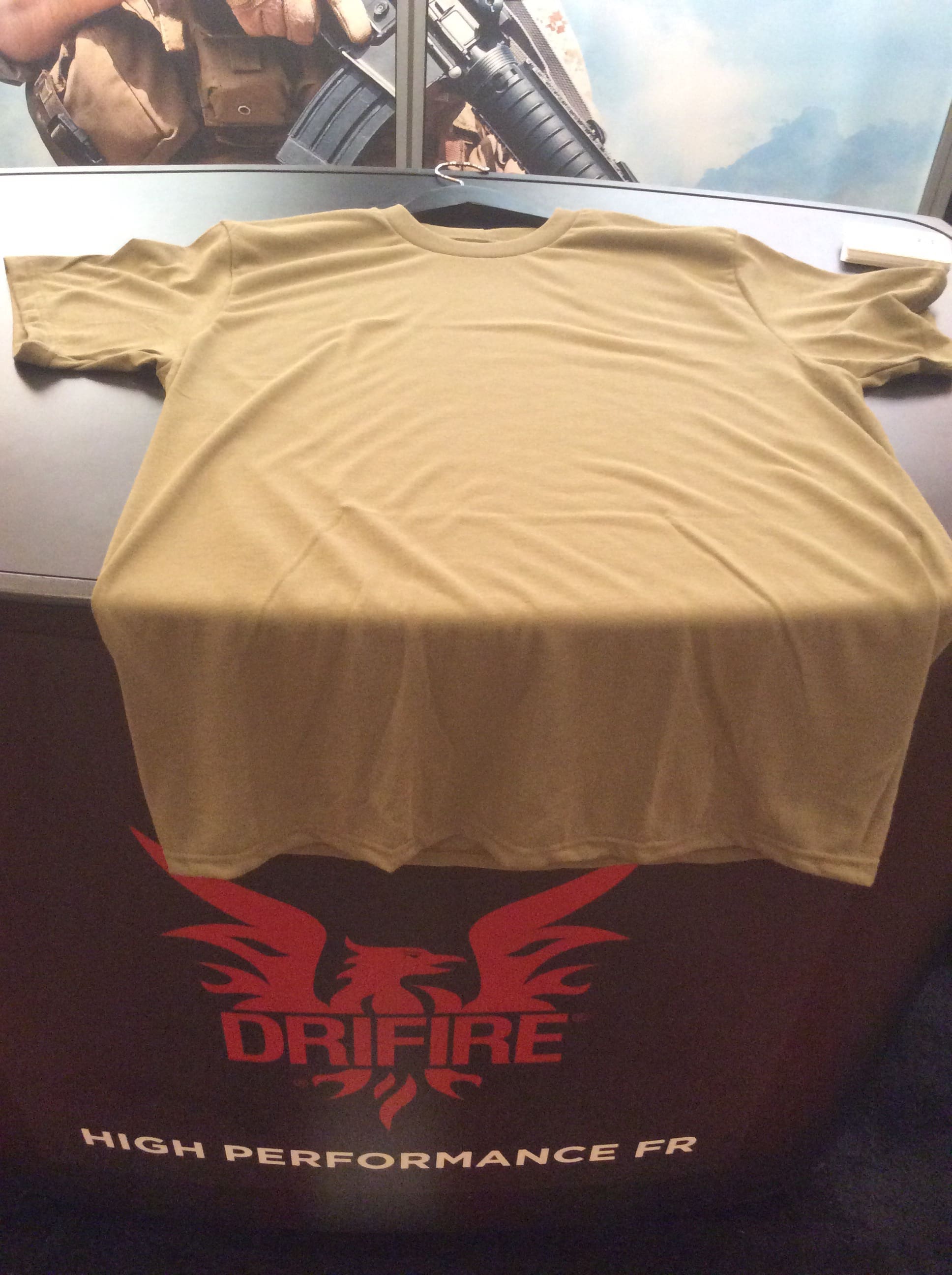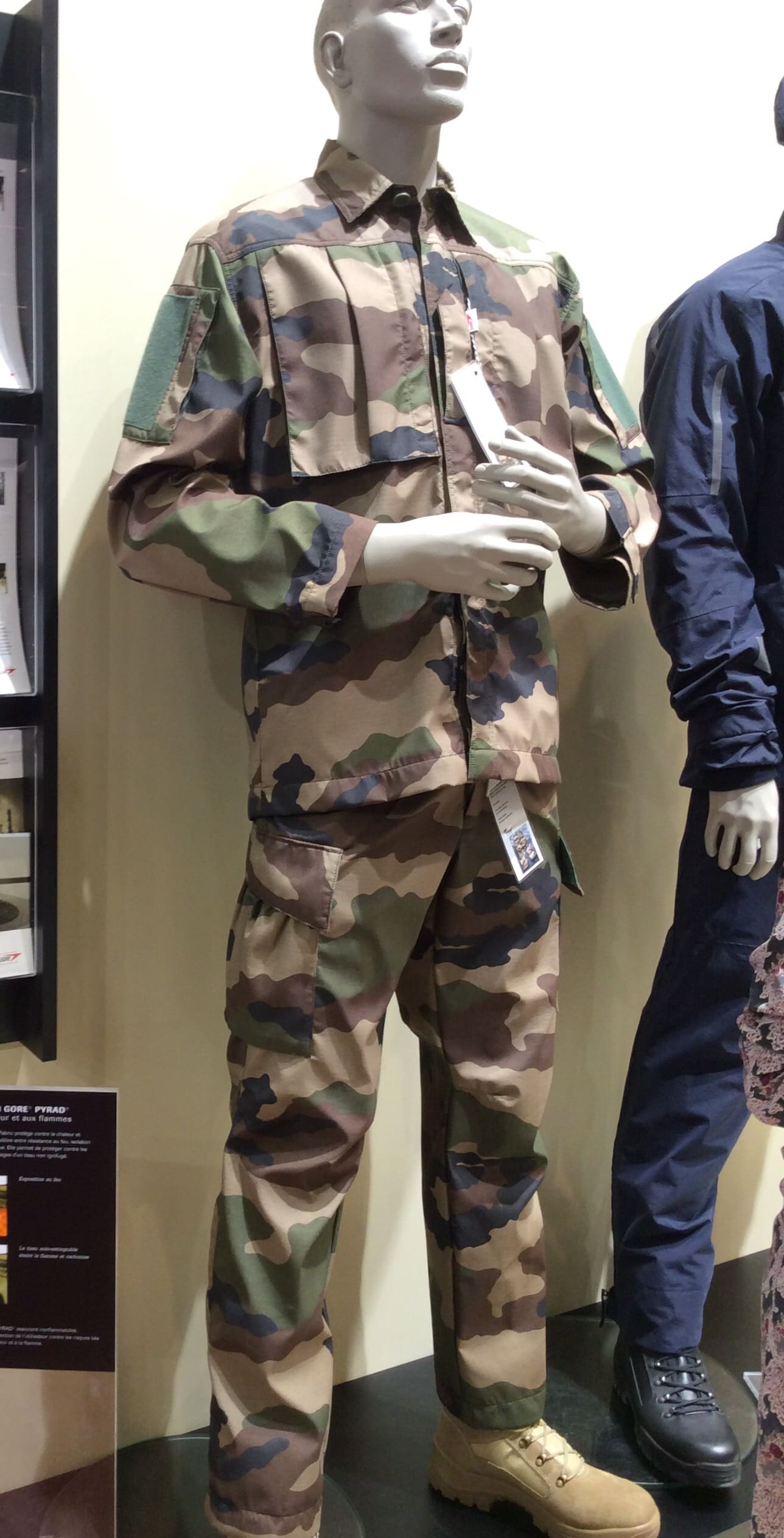
DRIFIRE has a Tan 499 FR Moisture Wicking T-shirt, both short and long sleeved. This is compatible with the new OCP ACU. The short sleeved T is available now through AAFES.

DRIFIRE has a Tan 499 FR Moisture Wicking T-shirt, both short and long sleeved. This is compatible with the new OCP ACU. The short sleeved T is available now through AAFES.
Massif has several new items this season and everything is available now.
First up is the Altitude Jacket and Pant. Made from SABA, a nonmembrane softshell. It’s an FR softshell for Infantry that is highly breathable intended for 3-season use due that incorporates DWR. You can move in it and not build up sweat. Plus, it’s the quietest fabric in Massif’s lineup. Think Level 3, action suit. They’ve slimmed the fit down a little and it’s meant to be worn by itself or with under layers. You’ll notice some common DNA in the Jacket’s layout but the Pant is something completely new. Look for zippered slash front Alpine pockets as well as low profile internal cargo pockets with Velcro closure. Rear pockets also close with Velcro.
Next up is the Rainier Winter Combat Shirt. It’s a hybrid design, crafted from Battleshied in the upper torso and arms for climate control which is an exclusive Gore FR stretch fabric for Massif. This is combined with FR SABA fabric in the torso for breathability. It’s a classic FR Combat Shirt design with a 1/4 zip front.
The Caldera is an FR Wind Shirt. It’s made from two fabrics. SABA on the upper torso and sleeves and a new fabric called BattleSkin on the torso. It’s a plaited fabric which means it’s a single layer fabric, knitted with a nylon face and a Nomex modacrylic on the back. This also means it’s very breathable and dries really fast. The Caldera boasts a walk dry time of 22 minutes which beats the pants off of the current mil-spec of 60 minutes.
I’ve often wondered what a combat uniform made from Gore Pyrad treated fabric would look like. I’m a big fan of the technology. Having heard that some work was being done in Europe I was excited to see this display. 
In this case, it’s the French Camouflage Centre Europe pattern, but the Pyrad treatment can be applied to most fabrics. As you can see, it doesn’t negatively affect the color of the pattern.
The fabric retains its basic properties yet becomes FR. So, for example, a waterproof breathable fabric remains so. It also doesnt feel heavy or hot. But, it’s not something that’s going to wash out.
www.goreprotectivefabrics.com/remote/Satellite/GORE-PYRAD-Product
Pre-Order for the highly anticipated PIG FDT Bravo FR gloves has commenced. Pre-Order customers get a special 20% off their purchase and will also be the first ones to receive their gloves before anyone else.
www.skdtac.com/PIG-FDT-Bravo-Gloves-p
This Combat Shirt is part of an ensemble of IED Fragment Protective Clothing created by Blücher’s Saratoga division which also includes bandana, protective collar, shorts and a shirt. Worn alone or in concert with one another, these garments increase the amount of body coverage against secondary projectile injuries.
In addition to providing environmental, camouflage and FR protection, the Fragment Protective Combat Shirt also stops secondary fragments such as dust, dirt and sand (v50 2gr RCc @ 320 m/sec, IAW STANAG 2920). These properties also mean that the material is cut and slash resistant.
Massif has long been known for their FR clothing solutions and the two items they showed me did not disappoint.

Designed to work in conjunction with Massif’s Fire and Ice Layering System, the FR Cool Knit is a moistire wicking fabric with a soft interior and four-way stretch for next-to-skin comfort. Flat seams don’t bunch up. Offered in Black and Coyote Tan.
Nitro Knit utilizes No Drip No Melt fabric technology from 37.5 for when you dont need full FR protection. The shirts are moisture wicking, have a comfortable hand, flat seams and are great for day-to-day wear. Offered in Black and Tan.
What can you say? It’s a balaclava. If you need one, this one is very nicely put together and I’ve liked it since I saw it at SHOT Show. The Assault Balaclava FR is made from TenCate Defender 5.5oz mesh which has a nice hand and won’t make you sweat like a pig in hot weather. It can be worn in either an “eyes exposed only” mode or “full face exposed” manner. You control your ventilation so you won’t overheat or fog your goggles up. Plus, it’s FR.
Available now in Crocodile and Wolf (shown) from Arc’teryx LEAF as well as tactical outfitters such as Tactical Distributors and US Elite.
SSD made this visit to DuPont back in August of 2010. The post offers a great look at the advantages of FR materials.
DuPont’s Spruance facility in Richmond, Virginia recently hosted SSD for an in depth look at Fire Resistance and Ballistic Protection.
Back in the 60s a new class of fabrics was developed, called Aramids with DuPont at the forefront of their creation. Two fabrics in this class have become the cornerstones of modern Soldier Survivability; Kevlar and Nomex. They provide Ballistic and Fire protection respectively. Kevlar was initially developed by DuPont for tire belts but not put to its current use until the early 70s. Nomex on the other hand was quickly integrated into flying and space suits not long after its creation.
The most compelling portion of the visit was the ThermoMan lab. Composed of 122 sensors, ThermoMan was designed with the assistance of NC State. In addition to the mannequin, there is also a skin burn injury model that takes data collected at the sensors and displays how a thermal threat would equate to an injury to the human body. One interesting aspect of the ThermoMan over other testing methods such as the commonly used vertical flame test is that the ThermoMan tests not only the material’s performance but also the garment’s overall design and construction. This is a critical factor in protecting a wearer from thermal threats. If a flame can get inside a garment then the wearer might as well not be wearing FR at all. Interestingly, the pocket configuration of the issue flight suit is designed to provide additional protection for the wearer by doubling the layers of Nomex in certain key areas. Testing has revealed that most injuries actually occur after the flame threat is removed and the wearer is subjected to residual heat retained by the garment.
We witnessed two burns consisting of a 3 second burn delivering 6 calories. It is intended to replicate a JP4 fire. In the first burn, an issue CWU-27/P US issue flight suit manufactured from Nomex III.
As you can see, minimal damage was sustained by the ThermoMan due to the material and design of the flight suit. it is important to note that while the ThermoMan does a great job predicting injuries, actual injuries may vary due to a wearers body and the fit of the garment. Experience has shown that 1% injury equates to 1 day in the hospital. In this case, the ThermoMan indicated 7% injuries.
In the second, a similar looking flight suit manufactured from 65/35 PolyCotton was subjected to the same threat. PolyCotton, a mixture of 65% Polyester and 35% Cotton is commonly found in Chinese made garments. There IS a place for this fabric, but as you will see in the video, it isn’t in a flame threat environment. Rather, PolyCotton is a cool fabric and very good for use in warm climates. The choice of materials goes back to our recent article concerning knowing your equipment, the threat, and environmental conditions and making an informed choice about which equipment to choose. As you can see the PolyCotton not only caught on fire but it continued to burn even after a direct flame was removed. In this case, the ThermoMan sustained 75% injuries.
During our visit to the ballistics lab we witnessed a demonstration of testing of an armor vest and were introduced to the various apparatus used during testing. Additionally, we were given the opportunity to try out first hand correctional armor which is designed to stop stab and puncture threats. We were amazed at how much differently ballistic and correctional armor reacted to the icepick type of shiv commonly found in correctional facilities. The bottom line is that correctional armor works.
We were fortunate enough to be able to discuss a variety of current Soldier Systems issues with the DuPont team but probably the most important message we got was that DuPont is constantly looking at new ways to use their flagship products. Adaptability is the key as they not work to improve the performance of their materials but also as they seek new ways to use their products as well as combine them with other fibers.
While in years past many vendors would have pushed monolithic solutions to threats, it makes more sense now to develop hybrid solutions that combine multiple fibers into a more robust material. This way, the best characteristics of different materials can be combined into a common solution.
Overall, the meeting was excellent and we left with a greater appreciation of the level of commitment DuPont has to protecting our troops and public safety professionals.